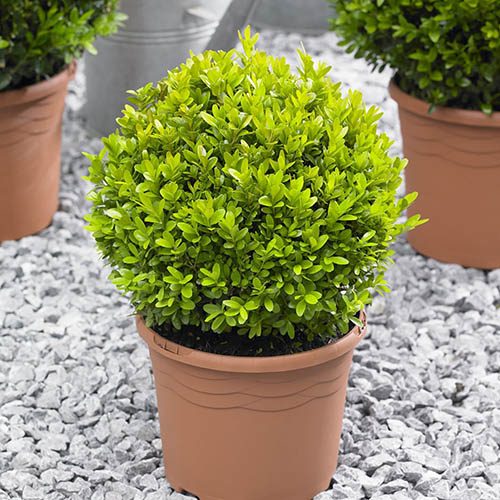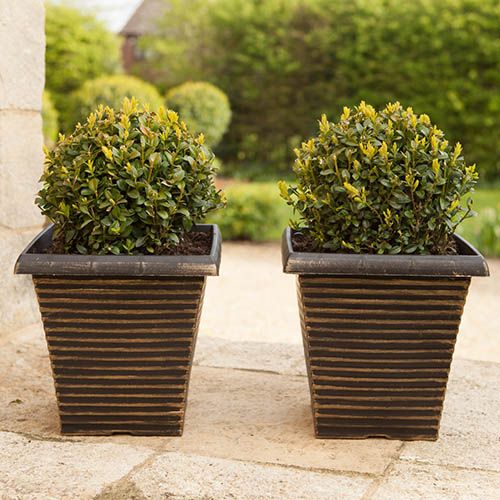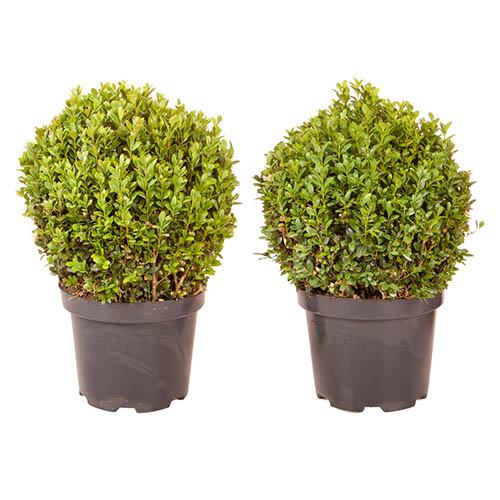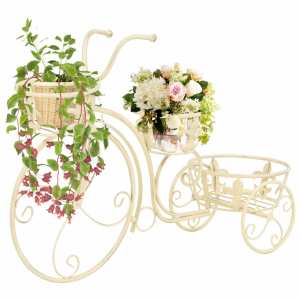Description

These evergreen shrubs are a favourite amongst landscape artists and homeowners alike. With their dense foliage and spherical shape, Buxus Balls are ideal for creating structure and adding a touch of sophistication to any outdoor space. They’re easy to maintain and can be shaped to suit all garden designs. In this blog post, explore the different ways of incorporating Buxus Balls into your garden, their care requirements, and the common issues to watch out for.
What are Buxus Balls?
Buxus balls, also known as Boxwood balls, are a popular and versatile landscaping element that adds both beauty and structure to gardens and outdoor spaces. These meticulously shaped and trimmed plants are created from the evergreen shrub species Buxus sempervirens, commonly known as boxwood.
Definition and Overview
Buxus balls are created by skilled horticulturists who carefully prune and shape boxwood plants into spherical or ball-shaped forms. The compact and dense foliage of boxwood makes it an ideal candidate for creating these distinctive and eye-catching garden features.
Buxus balls are often used to create formal and symmetrical designs in gardens, adding a touch of elegance and sophistication. They can be used as standalone features, placed strategically throughout a garden, or lined up to create a visual boundary along walkways or borders.
Types of Buxus Balls
There are various types of Buxus balls available, each offering its own unique aesthetic and purpose in garden design. Here are some popular types:
- Classic Buxus Balls: These are the traditional spherical Buxus balls that are commonly seen in formal gardens. They have a timeless appeal and provide a sense of order and structure to the landscape.
- Topiary Buxus Balls: These Buxus balls are shaped into intricate designs, often resembling animals, geometric shapes, or even human figures. Topiary Buxus balls showcase the artistry and creativity of the gardener, adding a whimsical touch to the garden.
- Mixed Buxus Balls: These Buxus balls combine different varieties of boxwood to create a visually interesting display. By mixing different leaf colours and textures, mixed Buxus balls add depth and dimension to the garden.
- Variegated Buxus Balls: These Buxus balls feature boxwood varieties with variegated leaves, such as Buxus sempervirens ‘Variegata’. The contrasting colours of the leaves create a striking visual impact and can be used to highlight specific areas in the garden.
- Potted Buxus Balls: These Buxus balls are grown in containers, making them portable and versatile. They can be easily moved around to suit changing design preferences or to add a touch of greenery to patios, balconies, or outdoor seating areas.
In conclusion, Buxus balls are an excellent choice for adding structure, elegance, and visual interest to gardens. With their variety of shapes and styles, they can be tailored to suit any garden design, whether formal or whimsical. These versatile landscaping elements are sure to captivate and delight both garden enthusiasts and casual observers alike.
Benefits of Buxus Balls
If you’re looking to enhance the aesthetic appeal of your garden or outdoor space, create privacy, and add boundaries, then Buxus Balls are the perfect choice. These versatile and low-maintenance plants offer a range of benefits that can transform your outdoor area into a beautiful and functional space.
Enhance Aesthetic Appeal
Buxus Balls are known for their elegant and timeless appearance. Their neatly clipped spherical shape adds a touch of sophistication to any garden or landscape. Whether you have a traditional or contemporary design, these plants effortlessly complement various styles, making them a versatile and popular choice among gardeners and landscapers.
The dense foliage of Buxus Balls provides a lush and green backdrop that can enhance the visual appeal of your outdoor space. Their vibrant green colour remains consistent throughout the year, ensuring your garden looks inviting and lively in every season. With their neat and compact form, Buxus Balls can be used as standalone features or incorporated into formal hedging, topiaries, or even in pots for a more versatile display.
Low Maintenance and Versatility
One of the key advantages of Buxus Balls is their low maintenance requirements. These plants are hardy and adaptable, making them suitable for a wide range of garden conditions. Buxus Balls thrive in both sun and shade, making them an ideal choice for gardens with varying light levels. Additionally, they are tolerant of different soil types, as long as the soil is well-draining.
Once established, Buxus Balls require minimal pruning, allowing you to spend more time enjoying your garden rather than tending to it. They can be easily shaped and trimmed to maintain their desired form, making them a versatile option for creating geometric patterns or adding structure to your outdoor space. With their slow growth rate, Buxus Balls retain their shape and size for longer periods, reducing the need for frequent maintenance.
Create Privacy and Boundaries
If privacy is a concern in your outdoor space, Buxus Balls can provide an effective solution. With their dense foliage and ability to grow into a compact and tight form, these plants create a natural barrier that shields your garden from prying eyes. Whether you want to create a private seating area or block out unsightly views, Buxus Balls offer a practical and aesthetically pleasing alternative to traditional fencing or walls.
In addition to creating privacy, Buxus Balls can also be used to define boundaries within your garden. By strategically placing these plants along paths, driveways, or garden borders, you can create a clear distinction between different areas, adding structure and organization to your outdoor space. Their versatility allows you to experiment with different arrangements, creating visually appealing and functional boundaries that guide visitors through your garden.
Buxus Balls offer numerous benefits for your garden or outdoor space. From enhancing aesthetic appeal to providing low maintenance and versatility, these plants can transform your outdoor area into a beautiful and functional space. Whether you want to add a touch of elegance, create privacy, or define boundaries, Buxus Balls are an excellent choice that will elevate the overall look and feel of your garden.
How to Care for Buxus Balls
Buxus balls, also known as boxwood balls, are popular ornamental plants that can add a touch of elegance to any garden or landscape. These perfectly trimmed evergreen shrubs are versatile and can be used as standalone focal points or as part of a larger design. To ensure that your Buxus balls thrive and maintain their beautiful shape, it is important to provide them with the proper care and attention they need. In this section, we will discuss the key aspects of caring for Buxus balls, including proper watering techniques, pruning and shaping, as well as protecting against pests and diseases.
Proper Watering Techniques
Watering is a crucial aspect of maintaining healthy Buxus balls. These plants prefer moist, well-drained soil, so it is important to water them regularly. However, overwatering can be detrimental to their health, leading to root rot and other issues. To strike the right balance, follow these watering techniques:
- Monitor soil moisture: Check the soil regularly by inserting your finger about an inch deep. If it feels dry, it’s time to water your Buxus balls.
- Water deeply: When watering, make sure to thoroughly soak the soil around the plant. This encourages the roots to grow deeper and ensures proper hydration.
- Avoid overhead watering: Instead of using sprinklers or spraying water from above, it is best to water at the base of the plant. This helps prevent the foliage from getting wet, reducing the risk of fungal diseases.
Pruning and Shaping
Pruning is an essential part of maintaining the desired shape and size of your Buxus balls. Regular pruning helps promote healthy growth and keeps the plants looking neat and tidy. Here are some tips to keep in mind:
- Timing: Prune your Buxus balls in late spring or early summer when the new growth begins to emerge. Avoid pruning during winter, as boxwoods are more susceptible to cold damage.
- Tools: Use sharp, clean pruning shears to make clean cuts without causing any damage. Disinfect your tools before and after pruning to prevent the spread of diseases.
- Shaping: To achieve the desired shape, trim the outer edges of the Buxus balls, working your way from the top to the bottom. Take care not to remove too much foliage at once to avoid stressing the plant.
Protecting against Pests and Diseases
While Buxus balls are generally resilient plants, they can fall victim to certain pests and diseases. Taking preventive measures can help keep your Buxus balls healthy and pest-free. Here are some ways to protect them:
- Inspect regularly: Regularly inspect your Buxus balls for any signs of pests such as leaf-eating caterpillars or aphids. Look out for yellowing leaves or unusual spots, which may indicate the presence of diseases.
- Remove affected foliage: If you notice any signs of pests or diseases, promptly remove the affected foliage to prevent further spread. Dispose of the pruned material properly.
- Encourage beneficial insects: Attracting beneficial insects like ladybugs and lacewings can help control pests naturally. Planting flowers such as marigolds and lavender nearby can help attract these beneficial insects.
Caring for your Buxus balls may require a bit of effort, but the results are well worth it. By following proper watering techniques, pruning and shaping regularly, and protecting against pests and diseases, you can ensure that your Buxus balls thrive and remain a stunning addition to your garden or landscape. Stay tuned for the next section, where we will explore additional tips and tricks to enhance the beauty of your Buxus balls.
Planting Buxus Balls
Buxus balls, also known as boxwood balls, are popular ornamental plants that add a touch of elegance to any garden or landscape. These neatly trimmed, spherical bushes are not only visually appealing but also relatively easy to care for. In this section, we will explore the key steps involved in planting buxus balls, including choosing the right location, preparing the soil, and essential tips for planting and transplanting.
Choosing the Right Location
When it comes to planting buxus balls, selecting the right location is crucial for their growth and overall health. Here are some factors to consider:
- Sunlight: Buxus balls thrive in partial shade to full sun conditions. While they can tolerate some shade, it’s important to ensure they receive at least 3-4 hours of direct sunlight each day for optimal growth.
- Soil Drainage: These plants prefer well-draining soil to prevent waterlogging, which can lead to root rot. Avoid areas with heavy clay soil, and instead, opt for loamy or sandy soil that allows excess water to drain away.
- Protection from Harsh Elements: Buxus balls are sensitive to strong winds and extreme temperatures. Consider planting them in areas protected from strong winds to prevent leaf damage. Likewise, providing some shelter from scorching sun or frosty conditions will help maintain their health.
Preparing the Soil
Before planting buxus balls, it’s essential to prepare the soil to create an ideal growing environment. Follow these steps to ensure your plants have the best start:
- Clear the Area: Remove any weeds, rocks, or debris from the planting area to provide a clean space for your buxus balls.
- Soil Amendment: Boxwood plants prefer slightly acidic soil with a pH range of 6.0 to 7.5. Test the soil pH and amend it accordingly using organic matter, such as well-rotted compost or peat moss, to achieve the desired acidity level.
- Loosening the Soil: Use a garden fork or tiller to loosen the soil to a depth of about 12 inches. This will improve soil aeration and drainage, allowing the roots to establish more easily.
Planting and Transplanting Tips
Once you have chosen the right location and prepared the soil, it’s time to plant or transplant your buxus balls. Here are some tips to ensure a successful planting process:
- Digging the Hole: Dig a hole that is slightly wider and deeper than the root ball of your buxus ball. This extra space will allow the roots to spread and establish more effectively.
- Positioning the Plant: Place the buxus ball in the hole, ensuring that the top of the root ball is level with or slightly above the soil surface. Avoid planting too deep, as this can lead to root suffocation and hinder growth.
- Backfilling and Watering: Gently backfill the hole with soil, firming it around the root ball to eliminate air pockets. After planting, water the buxus ball thoroughly to settle the soil and provide essential moisture for the roots.
- Mulching: Apply a layer of organic mulch, such as wood chips or bark, around the base of the plant. This helps retain moisture, suppresses weed growth, and regulates soil temperature.
- Watering and Maintenance: Buxus balls require regular watering, especially during dry spells. Ensure that the soil remains moist but not waterlogged. Additionally, trim and shape the plants annually to maintain their desired spherical form.
By following these planting and transplanting tips, you can ensure that your buxus balls thrive and become a stunning addition to your garden or landscape. Remember to provide the necessary care and attention to keep them healthy and vibrant for years to come.
Design Ideas for Buxus Balls
Buxus balls, also known as boxwood balls, are a versatile and beautiful addition to any garden. Their rounded shape adds a touch of elegance and structure to various garden styles. In this section, we will explore different design ideas for incorporating buxus balls into container gardens, formal gardens, and topiary designs.
Buxus Balls in Container Gardens
Container gardens offer a fantastic opportunity to showcase the beauty of buxus balls. Whether you have a small balcony or a spacious patio, these compact plants can be arranged in containers of varying sizes and shapes. By strategically placing buxus balls alongside other plants with contrasting textures and colors, you can create stunning focal points. Consider mixing buxus balls with vibrant flowers or trailing vines for a dynamic and visually appealing arrangement.
Buxus Balls in Formal Gardens
Formal gardens exude a sense of sophistication and orderliness. Buxus balls are a popular choice in formal garden designs due to their symmetrical shape and ability to maintain their form through regular pruning. Placed strategically along pathways or as border plants, buxus balls create a sense of structure and symmetry that enhances the overall aesthetic. Additionally, their evergreen foliage provides year-round interest, ensuring your formal garden remains visually appealing regardless of the season.
Buxus Balls in Topiary Designs
Topiary designs take the art of shaping plants to a whole new level, and buxus balls are a perfect fit for this creative endeavor. With their dense foliage and ability to withstand frequent pruning, buxus balls can be sculpted into various shapes and forms. From geometric patterns to whimsical animal shapes, the possibilities are endless. These living sculptures add a touch of whimsy and charm to any garden, and they can be a great conversation starter.
By incorporating buxus balls into container gardens, formal gardens, and topiary designs, you can elevate the visual appeal of your outdoor space. Whether you prefer a modern or traditional aesthetic, the versatility of buxus balls allows you to create a design that reflects your personal style. Experiment with different arrangements, textures, and shapes to add a unique touch to your garden. The possibilities are only limited by your imagination.
Common Issues with Buxus Balls
Buxus balls, also known as boxwood balls, are popular choices for adding structure and beauty to gardens and landscapes. However, like any plant, they can encounter certain problems that may affect their health and appearance. In this section, we will explore some common issues that can arise with buxus balls and how to address them effectively.
Browning and Yellowing Leaves
One of the most common problems encountered with buxus balls is the browning and yellowing of their leaves. This can be caused by several factors, including inadequate watering, nutrient deficiencies, or pest infestations.
To prevent browning and yellowing leaves, it is important to ensure that buxus balls receive proper watering. They prefer moist but well-draining soil, so make sure to water them regularly, especially during dry periods. Additionally, providing them with sufficient nutrients, such as a balanced fertilizer, can help maintain their health and vibrant green color.
If you notice browning or yellowing leaves on your buxus balls, it is essential to identify the underlying cause. Inspect the plants for signs of pests, such as aphids or mites, which can be treated with appropriate insecticides. Addressing nutrient deficiencies by fertilizing the plants will also help restore their vitality.
Winter Damage and Frost
Buxus balls are generally hardy plants, but they can suffer from winter damage and frost in colder climates. Freezing temperatures can cause the leaves and stems to become discolored, wilted, or even die back.
To protect buxus balls from winter damage and frost, it is advisable to apply a layer of mulch around the base of the plants in late autumn. This will help insulate the roots and retain moisture, preventing excessive freezing and thawing. Additionally, consider covering the plants with horticultural fleece or burlap during severe cold spells to provide an extra layer of protection.
In the event that winter damage occurs, it is important to assess the extent of the damage before taking any action. Prune away any dead or damaged branches in early spring, ensuring to make clean cuts just above a healthy bud or branch. With proper care and maintenance, buxus balls can usually recover from winter damage and regain their lush appearance.
Buxus Blight
Another issue that buxus balls may encounter is buxus blight, also known as boxwood blight. This fungal disease can cause significant damage to the plants, resulting in leaf drop, defoliation, and dieback.
Preventing buxus blight involves implementing good cultural practices, such as improving air circulation around the plants and avoiding overhead watering. Regularly inspect the buxus balls for any signs of blight, including brown or black lesions on the leaves or stems. If you suspect an infection, promptly remove and dispose of any affected plant material to prevent the spread of the disease.
To manage buxus blight, consider applying fungicides specifically formulated to combat the disease. Consult with a professional or local garden center for appropriate recommendations and follow the instructions carefully. It is crucial to act swiftly and decisively to minimize the impact of buxus blight on your buxus balls.
Boxwood Leafminer
The boxwood leafminer is a tiny, yellowish-orange fly whose larvae cause damage to buxus balls by tunnelling inside the leaves. Signs of infestation include discoloured or blistered leaves, premature leaf drop, and distorted growth.
To prevent boxwood leafminer infestations, maintain the health and vigour of the buxus balls through proper watering and fertilization. Prune and dispose of any infested leaves and branches to reduce the population of leafminer larvae. Additionally, consider using sticky traps or applying insecticides specifically targeted at leafminers to control their numbers effectively.
By being vigilant and taking proactive measures, you can minimize the impact of boxwood leafminers on your buxus balls and ensure their long-term health.
Remember, addressing common issues promptly and implementing preventive measures will help ensure that your buxus balls remain vibrant and healthy. In the next sections, we will explore various aspects of caring for these beloved plants, including pruning tips, suitable planting locations, and creative design ideas. Stay tuned!
Conclusion
In conclusion, Buxus balls are a versatile and striking addition to any garden or landscape. With their lush green foliage and elegant spherical shape, these plants provide a touch of elegance and sophistication. Whether used as standalone features or as part of a larger design, Buxus balls can create visual interest and add structure to outdoor spaces.
Not only are Buxus balls aesthetically pleasing, but they are also relatively low-maintenance. With regular pruning and attention to watering, these plants can maintain their shape and beauty for years to come. Additionally, Buxus balls are known for their resilience, making them suitable for various climates and environments.
From a gardening perspective, Buxus balls offer numerous benefits. They can be used to create formal hedges, edge flower beds, or define pathways. Their compact size makes them ideal for smaller gardens or containers, allowing for creative arrangements in limited spaces. Moreover, Buxus balls are amenable to shaping and can be sculpted into various designs, adding a unique touch to any outdoor setting.
To sum up, Buxus balls are not only visually appealing and easy to maintain, but they also offer a range of practical uses in landscaping. So why not explore the possibilities of incorporating these versatile plants into your outdoor space?




Anna –
I bought two of these plants for my aunt for Mother’s Day. They plants arrived early, a day before the delivery date but both plants were unhealthy and dying. My aunt loves plants and was very disappoint with these. I would ask for a refund but it’s too much trouble for my elder aunt to return them. I’m very disappointed.
tracy b –
Well established.. Soil had got in to the plant from the pot when I opened them but was perfect after a shake. Much better than any I’ve seen at larger garden centres
Amazon Customer –
Apart from damage to the packaging,which did not affect the plants,I was very pleased with my purchase.The plants were as illustrated and I would recommend them to friends and family
maria –
Beautiful beautiful!!!!has added character to the front of the house…would def recommend these as a must have…super easy to maintain
linda ann brooklinda ann brook –
I disentangle know what to expect with some of the reviews. They arrived box batter But the plants are amazing as my picture showsThank you so very much for the lovely plants kind regards LindaWest Yorkshire x
Avid Reader –
Nice healthy plants, still trying to find a suitable spot for them, but the plants are fine.
Javibena –
measure up, these are tiny, nothing misleading, just the actual plant looks small when u get it
V. B. AIKINS –
I am so very pleased with these Buxus. They are healthy and a rich green leaf. I have them placed in a white planter at the top of my front steps. They really do look stunning.
saramaking –
Verry fast delivery beautiful plants so pleased with them ime going to order some more also they were the cheapest on line highly recamend to others